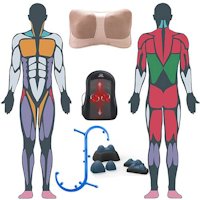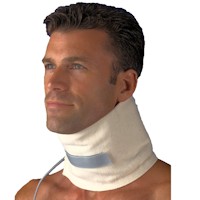Education For Coping With Neck Pain
Patients referred to a pain center or pain psychologist usually enter with apprehension and often interpret it as an indication that their pain is looked at as mainly psychological. The patient may be depressed or anxious and are often reluctant to discuss their feelings in depth, thinking that doing so will reinforce the view that they are psychologically disturbed instead of an education opportunity. They may be aware that their neck pain is affected by stress or mood, but indicate that the pain controls how they feel.
They generally lack information regarding the psychophysiology of pain in general and about the mechanisms contributing to their specific pain problems. Usually they have undergone many different attempts at treatment, none of which has resulted in significant or lasting relief. They have now been told they will have to learn to live with the pain, which translates into “nothing can be done”. This contributes to hopelessness and lack of responsibility for attempting any form of self help.
The Goal Of Education for Coping with Neck Pain
The goal here is to re-establish a sense of self worth in by providing information that enhances understanding of the potential for self help and motivates the patient to try.
Acknowledgment that depression, anxiety, low self esteem, social isolation, physical deactivation, irritability, along with other negative consequences are part of the chronic pain experience can be reassuring and reduce the sense of isolation, self criticism, and failure. This should contribute to feelings of being understood and treated with respect.
Mechanics Of Pain
Comprehension of the mechanics by which pain is communicated through is helpful for application and maintenance of pain management techniques.
 There are different roads by which different types of pain travel. Pressure and touch are on a fast road. Sharp, stabbing pain travels on a slower road and goes to the part of the brain called the cortex and produces the experience, “ouch.”
There are different roads by which different types of pain travel. Pressure and touch are on a fast road. Sharp, stabbing pain travels on a slower road and goes to the part of the brain called the cortex and produces the experience, “ouch.”
The dull, aching, and burning pains, often associated with chronic pain syndromes, travel the slowest road and goes to a different part of the brain, called the limbic system, which is the emotional center and produces the feeling of dismay. One instinctively rubs an arm that has bumped into an object as sensations of touch or rubbing travel quickly and beat sharp pain, which travels more slowly, to the brain. The sensation of rubbing interferes with the sensation of sharp pain.
This also relates to the important differentiation between pain and suffering, harm and hurt. The goal is to reduce the speed, strength, or volume of the transmission of pain. Complete elimination of the pain is not typically a realistic goal. Reduction of the pain or suffering, however, is both realistic and possible.
 Muscle Therapy Tools Muscle Therapy Tools |
 Heat Therapy Heat Therapy |
 Topical Pain Relievers Topical Pain Relievers |
Neurotransmitters are chemical messengers that influence both mood and the experience of pain. Endorphins and enkephalins are the body’s own natural pain killers and are promoted by exercise. Many other naturally produced neurotransmitters also affect pain and these neurotransmitters can increase or decrease the pain message. Pain management techniques such as relaxation and cognitive re-framing or thought analysis and control can increase release of neurotransmitters that decrease pain and decrease release of those that increase pain. Patients either refusing to try a potentially helpful medication or resisting reduction of a narcotic, may become more cooperative when they are educated as to how the medications work.
Synthetic neurotransmitters (medications) have benefits – serotonin enhancement and costs – ultimately suppressing endorphin and enkaphalin production by opioids. The role played by a neurotransmitter or medication can vary, depending on location in the body. For example, mood improvement results from the action of antidepressants on nerve cells in the brain, whereas pain reduction results from their actions in the body.
This can relate to motivation to maintain higher than desirable levels of a medication results from its action in the brain, and its effect on mood, more than from its action in their body and on pain. Many chronic pain patients become attached to hydrocodone compounds because in some these drugs boost energy and enhance mood. Realizing this may change a willingness to try alternative and more appropriate medication and to consider the contributions of pain versus suffering in the pain experience.
Education for Coping with Neck Pain: Treatment Goals
Treatment goals in pain management focuses what you can do to help yourself. If professionals are involved, the treatment team can be compared with a personal trainer who guides a person through establishing an appropriate workout. The goal is not to learn to live with the pain, but rather to learn to control the pain by altering or eliminating behaviors and thoughts that unknowingly increase the perception of pain and by learning how to use techniques that have the potential to reduce the current perception of pain.
Flare-ups or bad days are to be expected, and temporary increases in pain should not be considered major setbacks. For education, patients are taught to manage flare-ups by active application of their pain management skills, which include recognizing and re-framing or changing thoughts that intensify and lengthen the experience into a potential relapse.
A 2018 study in JAMA Neurology indicates that pain neuroscience education combined with specific exercise appears more effective than general physiotherapy for improving pain, signs of central sensitization, disability, physical and mental functioning, as well as pain cognitions in those with chronic spinal pain.
The next part is Cognitive-behavioral Therapy for Neck Pain
Coping with Neck Pain | Cognitive-behavioral Therapy for Neck Pain | Relaxation and Biofeedback for Neck Pain | Active Adaptation for Neck Pain | Coping with Neck Pain Conclusion
